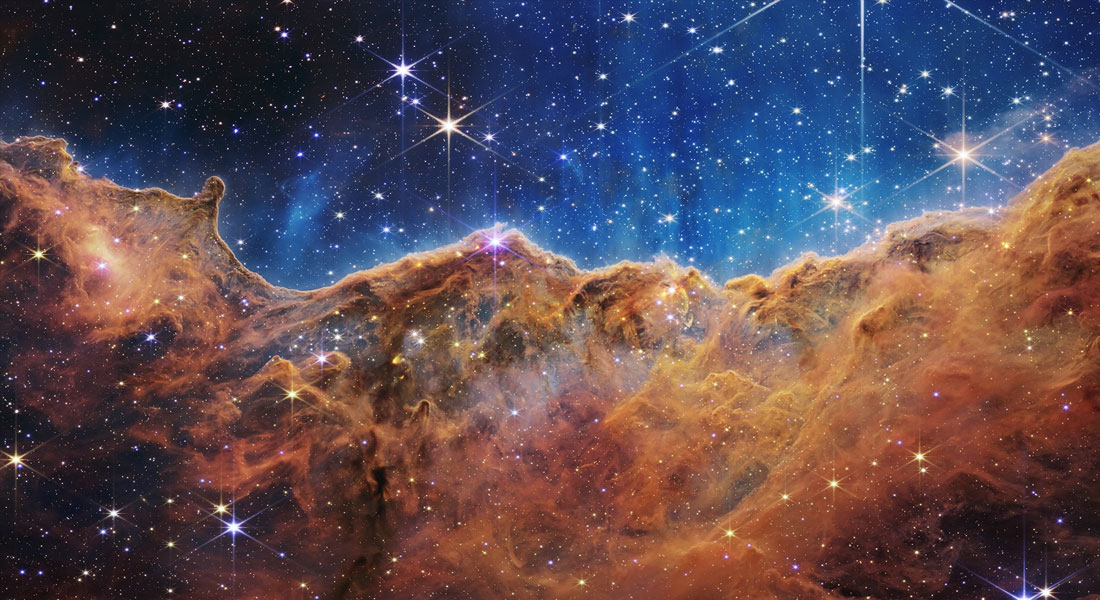Invisible Galaxies, Through a Scientist’s Eyes
Glimpsing into the galaxies of the past: that is the daunting task that students from the University of Copenhagen have undertaken by analysing so-called Lyman-α emission. While this radiation, stemming from hydrogen, is difficult to observe, investigating alternative quantities from light spectra can depict a more accurate representation of early galaxies and their characteristics.

What is Lyman-α?
Studying invisible galaxies requires a powerful tool, and light is the key, allowing us to glean into the farthest reaches of the Universe.
Lyman-α light (1216Å or 121.6nm) has just the energy needed to excite the electron in a hydrogen atom to its first level. By doing so, the Lyman-α photon is “absorbed,” and after roughly a nanosecond, the electron de-excites to its ground state, releasing energy in the form of Lyman-α radiation. A little more or a little less energy than needed, and the hydrogen atoms would be left unchanged.
With hydrogen being the most abundant element in the universe, studying Lyman-α spectra offers us a treasure trove of knowledge on the intricacies and particulars of galaxies — information such as temperature, density, dust content, and velocity. Its great luminosity allows it to be observed at high redshift, meaning even the Universe’s oldest galaxies lie within our grasp.
Gonzalo Juan Prieto-Lyon, PhD student at the Cosmic Dawn Center at the Niels Bohr Institute, aims to further shed light on the potential of Lyman-α emission in studying various aspects of galaxies, particularly those from the Epoch of Reionization.
How is Lyman-α relevant to the Epoch of Reionization?
With the universe completely ionised, Lyman-α radiation could cover light years undisturbed, and so the data we receive from observing its spectra would be accurate to the features of the galaxy it was emitted from. In the intergalactic medium, however, interfering hydrogen atoms absorb and re-emit Lyman-α energy, radiating it in all directions and consequently affecting the reliability of our observations.

Neutral hydrogen absorbs Lyman-α whereas ionised hydrogen is simply bypassed. Therefore, we can trace the end of the EoR by looking at spectra where the Lyman-α emissions cease to exist.
Moreover, the redshift of a galaxy can be approximated using this same information, with the setback that the wavelengths used in calculations may have been affected by factors such as clouds of hydrogen and ionised bubbles.
Knowing a galaxy’s redshift reveals how far back we are looking in time— which allows us to have discovered some of the oldest galaxies yet.
How do we analyse Lyman-α data?
Due to the neutral nature of the intergalactic medium, Lyman-α emitted by galaxies during the Epoch of Reionization is absorbed or otherwise scattered out of sight, making it difficult to observe. Prieto-Lyon is one of the scientists to rise to this challenge by investigating observable quantities that can shed light on the behaviour of Lyman-α.
"The idea is to make a ‘baseline’ model of a general Lyman-α emitting galaxy using observations outside the Epoch of Reionization, where Lyman-α is more easily observed," Prieto-Lyon explains. "Then we can use that model to better understand how Lyman-α works inside the Epoch of Reionization."
This alternative method includes studying characteristics such as the brightness of a galaxy across the entire UV spectrum and making interpretations based on the UV magnitude (total brightness) and the slope of the spectra obtained.
"A faint UV magnitude implies a galaxy that is less massive, with less hydrogen and dust to "kill" Lyman-α," clarifies Prieto-Lyon. "Fainter galaxies are also indicative of younger stellar populations, which emit more ionising energy. We can expect faint galaxies of small UV magnitudes to have strong Lyman-α emissions."
Similarly, a spectral slope skewed towards blue wavelengths would also imply more Lyman-α, as it indicates "a population of strongly ionising stars, and/or a lack of dust which absorbs preferentially blue light."
If Lyman-α emission is interpreted successfully, the shape of its spectral line can give us invaluable information about the galaxies it originates from – knowledge of their temperature, velocity, and much, much more. Due to the difficulties associated with observing it, however, other quantities such as the UV magnitude and slope are studied.
Gonzalo Prieto-Lyon is currently working on an article on his analysis, and is looking forward to sharing his results. "It is important to note that we cannot exactly predict the strength of Lyman-α," he cautions. "My results do however give the probability for a galaxy to have a certain Lyman-α strength."
Contact
This article is written by Ani Nahapetyan, high-school student at Birkerød Gymnasium, in partial fulfillment of the International Baccalaureate Program. Ani Nahapetyan has interviewed PhD student Gonzalo Prieto-Lyon about his work at the Cosmic Dawn Center.
Supervisor
Publication
Gonzalo Juan Prieto-Lyon is currently finishing the study described here, and is planning to submit it to the scientific journal Astronomy & Astrophysics. Once it is published, a link will appear here.
The Cosmic Dawn Center
The Cosmic Dawn Center (DAWN) is an international basic research center funded by the Danish National Research Foundation.
The center is dedicated to uncovering how and when the first galaxies, stars and black holes formed.
As a cooperation between two universities, DAWN is located in Copenhagen at the Niels Bohr Institute, University of Copenhagen, and at the National Space Institute of the Danish Technical University (DTU-Space).
